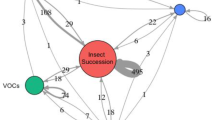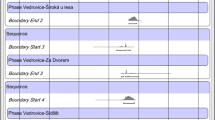Abstract
Stevens et al. (Oxford J Archaeol 29: 407–428, 2010) speculated that the extensive faunal intra-population isotopic variability at Danebury hillfort was due to the animals being husbanded within various ecological isozones (i.e. microenvironments with distinct natural or anthropogenic isotopic baselines) within the Danebury Environs, and subsequently brought to the hillfort. We test this hypothesis through isotopic analysis of 357 animals from five sites in the Danebury Environs (Suddern Farm, Nettlebank Copse, Houghton Down, New Buildings, Bury Hill). Our results demonstrate that the hypothesis is incorrect as the Environs animals also exhibited extensive intra-site isotopic variability. The observed patterns require considerable human management of herds and flocks, either through animal droving over long distances, or movement restriction through personal attendance or penning/corralling within a landscape containing a mosaic of isozones. Large-scale importation of animals to the Danebury sites from distant regions that have different isotopic baseline values is possible. However, the practical requirements of this model (i.e. long distance trade networks maintained in terms of frequency, proportion and source of animals over 500 years) make this improbable. Rather, we propose a model that includes distinct ecological isozones within the Danebury Environs landscape, with some animals from each of the sites consuming foodstuff from different isozones for most of their lives. This likely involves control of the landscape on a communal probably kinship basis, with individuals having access to certain parts of the landscape at certain times. The landscape could be seen as being made up of numerous interlocking activity-territories, defined in both space and time, remembered and inherited. Irrespective of which model proves to be the most accurate, these results paint a picture of complex land management during the Iron Age.








Similar content being viewed by others
References
Albarella U (2007) The end of the sheep Age: people and animals in the late iron Age. In: Haselgrove C, Moore T (eds) The late iron Age in Britain and beyond. Oxbow, Oxford, pp 393–406
Ambrose SH, Norr L (1993) Experimental evidence for the relationship of the carbon isotope ratios of whole diet and dietary protein to those of bone collagen and carbonate. In: Lambert JB, Grupe, G (eds), Prehistoric Human Bone—Archaeology at the Molecular Level. (Berlin) 1–37
Amundson R, Austin AT, Schuur EAG, Yoo K, Matzek V, Kendall C, Uebersax A, Brenner D, Baisden WT (2003) Global patterns of the isotopic composition of soil and plant nitrogen. Global Biogeochem Cycles 17(1):1031
Bendrey R, Hayes TE, Palmer MR (2009) Patterns of Iron Age horse supply: an analysis of strontium isotope ratios in teeth. Archaeometry 51(1):140–150
Bocherens H, Drucker D (2003) Trophic level isotopic enrichment of carbon and nitrogen in bone collagen: case studies from recent and ancient terrestrial ecosystems. Int J Osteoarchaeol 13:46–53
Bogaard A (2012) Middening and manuring in Neolithic Europe: issues of plausibility, intensity and archaeological method. In: Jones RL (ed) Manure: historical, archaeological and ethnographic perspectives. Ashgate, Farnham, pp 25–40
Campbell G (2000) Plant utilization: the evidence from charred plant remains. In: Cunliffe B (ed) The Danebury environs programme volume 1: introduction. English Heritage and Oxford University Committee for Archaeology, Monograph 48, Institute of Archaeology, Oxford, pp 45–59
Cunliffe B (1984a) Danebury: An Iron Age Hillfort in Hampshire. Vol. 2 The Excavations 1969–1978: The Finds. CBA Research Report No. 52b, London
Cunliffe B (1984b) Danebury: An Iron Age Hillfort in Hampshire. Vol. 1 The Excavations 1969–1978: The Site. CBA Research Report No. 52a, London
Cunliffe B (1993) Danebury. English Heritage, London
Cunliffe B (1995) Danebury: An Iron Age Hillfort in Hampshire. Vol. 6. A Hillfort Community in Perspective. CBA Research Report No. 102, York
Cunliffe B (1986) Danebury: anatomy of an Iron Age hillfort. Batsford, London
Cunliffe B (2000) The Danebury environs programme: the prehistory of a Wessex landscape: volume 1—introduction. English Heritage and Oxford University Committee for Archaeology, Oxford
Cunliffe B, Poole C (2000a) The Danebury environs programme: the prehistory of a Wessex landscape: volume 2—part 2: Bury Hill, Upper Clatford, Hants, 1990. English Heritage and Oxford University Committee for Archaeology, Oxford
Cunliffe B, Poole C (2000b) The Danebury environs programme: the prehistory of a Wessex landscape: volume 2—part 3: Suddern Farm, Middle Wallop, Hants, 1991 and 1996. English Heritage and Oxford University Committee for Archaeology, Oxford
Cunliffe B, Poole C (2000c) The Danebury environs programme: the prehistory of a Wessex landscape: volume 2—part 4: New Buildings, Longstock, Hants, 1992 and Fiveways, Longstock, Hants, 1996. English Heritage and Oxford University Committee for Archaeology, Oxford
Cunliffe B, Poole C (2000d) The Danebury environs programme: the prehistory of a Wessex landscape: volume 2—part 5: Nettlebank Copse, Wherwell, Hants, 1993. English Heritage and Oxford University Committee for Archaeology, Oxford
Cunliffe B, Poole C (2000e) The Danebury environs programme: the prehistory of a Wessex landscape: volume 2—part 6: Houghton Down, Stockbridge, Hants, 1994. English Heritage and Oxford University Committee for Archaeology, Oxford
Davis SJM (1987) The archaeology of animals. Batsford, London
Dawson TE, Mambelli S, Plamboeck AH, Templer PH, Tu KP (2002) Stable isotopes in plant ecology. Annu Rev Ecol Syst 33:507–559
DeNiro MJ (1985) Postmortem preservation and alteration of in vivo bone collagen isotope ratios in relation to palaeodietary reconstruction. Nature 317:806–809
Fowler P (1983) The farming of prehistoric Britain. Cambridge University Press, Cambridge
Fraser R, Bogaard A, Heaton T, Charles M, Jones G, Christensen BT, Halstead P, Merbach I, Poulton PR, Sparkes D, Styring A (2011) Manuring and stable nitrogen isotope ratios in cereals and pulses: towards a new archaeobotanical approach to the inference of land use and dietary practices. J Archaeol Sci 38:2790–2804
Grant A (1984) Animal husbandry. In Cunliffe B (ed) Danebury: An Iron Age Hillfort in Hampshire. Vol. 2 The Excavations 1969–1978: the Finds. CBA Research Report No. 52b, London
Grant A. (1991) Animal husbandry. In Cunliffe B, Poole C (eds) Danebury: An Iron Age Hillfort in Hampshire. Vol. 5 The Excavations 1979–1988: the Finds. CBA Research Report No. 73b, London
Green M (1992) Animals in Celtic life and myth. Routledge, London, pp 5–21
Hambleton E (2008) Review of Middle Bronze Age—Late Iron Age faunal assemblages from Southern Britain. English Heritage Research Department Report Series 71.
Hamilton J (2000) Animal husbandry: the evidence from the animal bones. In: Cunliffe B (ed) The Danebury Environs programme volume 1: introduction. English Heritage and Oxford University Committee for Archaeology Monograph 48, Oxford, pp 59–76
Heaton THE (1999) Spatial, species, and temporal variations in the 13C/12C ratios of C3 plants: implications for palaeodiet studies. J Archaeol Sci 26:637–649
Hedges REM, Reynard LM (2007) Nitrogen isotopes and the trophic level of humans in archaeology. J Archaeol Sci 34:1240–1251
Hoefs J (1997) Stable isotope geochemistry. Springer, Berlin
Jay M, Richards MP (2007) British iron Age diet: stable isotopes and other evidence. Proc Prehist Soc 73:171–192
Jones J, Mulville J, McGill R, Evershed RJ (2012) Palaeoenvironmental modelling of δ13C and δ15N in the North Atlantic Islands: understanding past marine resource use. Rapid Commun Mass Sp 26(20):2399–2406
Jones MK (1984) The plant remains. In: Cunliffe B (ed) Danebury: An Iron Age Hillfort in Hampshire. The Excavations 1969–1978: The Finds. CBA Research Report No 52b, vol. 2. London, pp. 483–495
Jones MK, Nye S (1991) The plant remains. In: Cunliffe B, Poole C (eds) Danebury: An Iron Age Hillfort in Hampshire. The Excavations 1979–1988: TheFinds. CBA Research Report No 73b, vol. 5. London, pp. 439–447
Jones MK (1995) Patterns in agricultural practice: the archaeobotany of Danebury in its wider context. In: Cunliffe B. (ed) Danebury: An Iron Age Hillfort in Hampshire. A Hillfort Community in Perspective. CBA Research Report No 102, vol.6. London, pp. 43–50
Kelly F (1997) Early Irish farming. School of Celtic studies, Dublin Institute for Advanced Studies
Lightfoot E, Stevens RE (2012) Stable isotope investigations of charred barley (Hordeum vulgare) and wheat (Triticum spelta) grains from Danebury Hillfort: implications for palaeodietary reconstructions. J Archaeol Sci 39(3):656–662
Madgwick R, Mulville J, Stevens RE (2013) Isotopic analysis of fauna from British middens of the Late Bronze Age: Evidence for diversity in foddering strategy and herd management. Environmental Archaeology. In press
Millard AR, Jimenez-Cano NG, Lebrasseur O, Sakai Y (2011) Isotopic investigation of animal husbandry in the welsh and English periods at dryslwyn castle, Carmarthenshire, Wales. Int J Osteoarchaeol. doi:10.1002/oa.1292
Mulville J, Madgwick R, Stevens RE, O’Connell T, Craig O, Powell A, Parker Pearson M, Sharples NM (2009) Isotopic analysis of faunal material from South Uist, Western Isles, Scotland. J North Atl 2:51–59
Privat KL, O’Connell TC, Richards MP (2002) Stable isotope analysis of human and faunal remains from the Anglo-Saxon cemetery at Berinsfield, Oxfordshire: dietary and social implications. J Archaeol Sci 29:779–790
Schoeninger MJ, DeNiro MJ, Tauber H (1983) Stable nitrogen isotope ratios of bone collagen reflect marine and terrestrial components of prehistoric human diet. Science 220:1381–1383
Stevens RE, Hedges REM (2004) Carbon and nitrogen stable isotope analysis of northwest European horse bone and tooth collagen, 40,000 BP–present: palaeoclimatic interpretations. Quaternary Sci Rev 23(7–8):977–991
Stevens RE, Jacobi RM, Street M, Germonpré M, Conard NJ, Műnzel SC, Hedges REM (2008) Nitrogen isotope analyses of reindeer (Rangifer tarandus), 45,000 BP to 9,000 BP: Palaeoenvironmental reconstructions. Palaeogeogr Palaeoclimatol Palaeoecol 262(1–2):32–45
Stevens RE, Lightfoot E, Hamilton J, Cunliffe B, Hedges REM (2010) Stable isotope investigations of the Danebury hill fort pit burials. Oxford J Archaeol 29:407–428
Stevens RE, Lightfoot E, Hamilton J, Cunliffe B, Hedges REM (2013) Investigating dietary variation with burial ritual in Iron Age Hampshire: an isotopic comparison of Suddern Farm Cemetery and Danebury hillfort pit burials. Oxford J Archaeol. In press
Tieszen LL, Fagre T (1993) Effect of diet quality and composition on the isotopic composition of respiratory CO2, bone collagen, bioapatite, and soft tissues. In: Lambert JB, Grupe G (eds) Prehistoric human bone—archaeology at the molecular level. Springer Berlin pp.121–155.
Ubelaker DH, Katzenberg MA, Doyon LG (1995) Status and diet in pre-contact highland Ecuador. Am J Phys Anthropol 97:403–412
Ugan A, Coltrain J (2011) Variation in collagen stable nitrogen values in black-tailed jackrabbits (Lepus californicus) in relation to small-scale differences in climate, soil, and topography. J Archaeol Sci 38(7):1417–1429
Vogel JC, van der Merwe NJ (1977) Isotopic evidence for early maize cultivation in New York State. Am Antiq 42:238–242
Acknowledgments
The authors would like to thank Kay Ainsworth at Hampshire Museum stores for providing access to the material, records and unpublished information. Peter Ditchfield is thanked for help with mass spectrometry. Jacqui Mulville is thanked for useful discussions. EL would like to thank Darwin College for financial support; RS would like to thank the Royal Society and NERC for financial support.
Author information
Authors and Affiliations
Corresponding author
Electronic supplementary material
Below is the link to the electronic supplementary material.
Online supplementary dataset 1
Sample provenance, isotope results and atomic C/N ratios. (XLS 91 kb)
Rights and permissions
About this article
Cite this article
Stevens, R.E., Lightfoot, E., Hamilton, J. et al. One for the master and one for the dame: stable isotope investigations of Iron Age animal husbandry in the Danebury Environs. Archaeol Anthropol Sci 5, 95–109 (2013). https://doi.org/10.1007/s12520-012-0114-3
Received:
Accepted:
Published:
Issue Date:
DOI: https://doi.org/10.1007/s12520-012-0114-3




